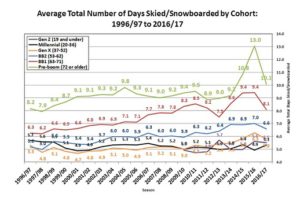As baby boomers leave ski slopes, millennials fail to fill gap
Low ski visits from young adults force resorts to change outreach methods

PARK CITY—Ski resorts expect older, wealthier individuals who have the time and money to ski more. What is not expected is as that generation retires from skiing, fewer youth replace their spots on the chairlifts.
Jim Powell, vice president of marketing at the Park City Chamber/Bureau, said this is a trend that ski resorts are seeing more and more every year. Millennials simply do not ski or snowboard as much as the baby boomers.
“Skiing is not a growing sport,” he said. “We have a problem — the baby boomers are aging out. And they have been a big source of skier days.”
Powell said it takes about two millennials to replace every baby boomer who hangs up his or her skis. Young adults between the ages of 20 and 36 tend to ski less during the season and they do not spend as much money.
Part of the problem is that millennials, who are in their late 20s and early 30s, are in the stage of life that regularly drops skiing because of everything else they are doing, said Michael Berry, president of National Ski Areas Association based in Colorado.
“You’re possibly getting married, you’re possibly launching a career, or you’re possibly buying a home. Or maybe all three of those things,” he said. “That distracts you, except for the most serious participants, from the idea that you might have time and the financial ability to be able to spend a weekend or a couple of days or even a day skiing.”
The trend is predictable, because many come back seven or 10 years later — after they have a steady job and kids, and they want their kids to participate in the sport they love, Berry said. That differs from baby boomers, who, at that pivotal point in their life, were still skiing more.
The cohort of snowsports participants between the ages of 20 and 36 in Park City had continual growth from 1996 to 2009. As millennials aged to fill the cohort, numbers have remained fairly flat, according to data from RRC Associates.
Ski resorts like Deer Valley have seen the changes coming as well. Two seasons ago, their average skier age increased by five years and there were far more 55 to 60 year olds, said Coleen Reardon, branding manager for the resort. They adapted their marketing strategy to target a younger audience, and the resort’s average age dropped two years.
Some resorts, such as Vail Resort’s EPIC pass and the Mountain Collective, target millennials who enjoy variability with passes that allow one to try several ski areas, Powell said.
Berry and Powell both recognize that the cost of skiing has increased, especially in destination resorts.
The average adult weekend ticket price at resorts in the Rocky Mountain region has risen from $106.79 during the 2013-14 to $134.32 last season, according to a graph from NSAA. Data from RRC Associates shows that the average daily rate of lodging in Park City continues to rise, and young adults cannot keep up, they said.
Millennials are low on funds because of student debt and expensive housing and low on time because of “normal” 60-hour work weeks that the previous generation did not see to the same extent, Berry said.
In order to bring them back, resorts have to get creative.
“Each individual area has (its) own strategy,” he said. “What kind of activities can you create that will draw (millennials) out in a way that will be beneficial and remind them what a wonderful sport and activity it really is?”
The Chamber/Bureau attracts millennials by showing off not only skiing and snowboarding, but unique adventures and nightlife in Park City on social media channels and online television and music ads, Powell said. The ads reach big cities such as Los Angeles, Chicago, Dallas, Washington DC, New York, Miami, Atlanta, San Francisco and Boston, which tend to have high populations of young adults. The Chamber/Bureau also wants to showcase the diversity of things to do in Park City, since Powell has noticed that one of the reasons millennials ski less is that they often choose to participate in various activities.
“They are looking for different kinds of adventures,” he said. “The boomers were more, ‘Hey we’re on vacation. We ski every day on vacation. That’s what we do.”
Millennials might ski a few days, but also rent fat tire bike or go to the Homestead Crater for paddleboard yoga. By advertising that there is more to do than just ski in Park City, Powell hopes that more millennials will come.
Posted from the Summit Daily




